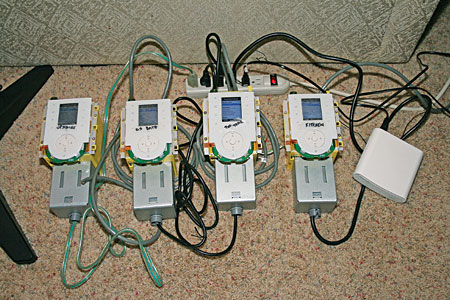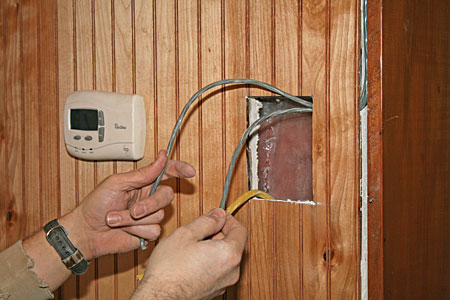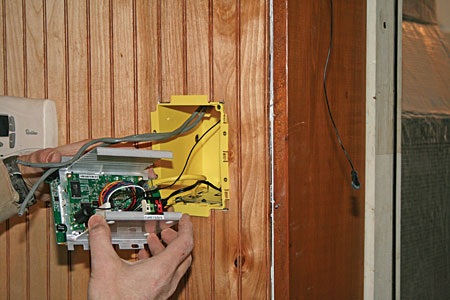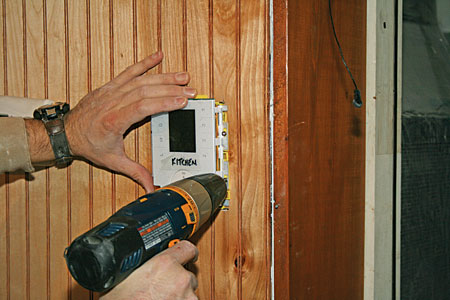Russound Collage Powerline Media and Intercom System Page 2

The Collage Amplified Keypad measures just under 5 by 6.5 inches. The front face features a 240-by-320 color LCD panel that’s flanked by a column of four backlit capacitive-touch buttons on each side. The iPod-style click wheel under the display scrolls through menus, adjusts volume, and changes tracks. Each keypad has a built-in 15-watt-per-channel (30 wpc in mono mode) amplifier, a microphone for intercom use, and an FM tuner with RDS (for listening in the local zone). It also has a light sensor that you can set to automatically adjust the brightness of the LCD panel depending on the amount of light in the room.
A Starring Member of the Gridcast
For an in-wall multiroom audio system, the Collage is surprisingly easy to install. Other than that, the Collage setup is equally simple. However, the one hitch to doing it yourself is that, unlike most multiroom audio systems that only involve low-voltage wiring, you’ll need to wire the Collage Amplified Keypads directly into your home’s electrical wiring. Russound highly recommends that you use a licensed electrician for this part. Fortunately, the electrician doesn’t need to know anything about audio systems, computers, or media streaming. He just needs to connect the wires and mount the box in the wall.
However, before the electrician gets involved, you’ll need to bind the keypads to the Collage Media Manager. To do this, you’ll need to plug all of the keypads into the same power strip along with the Collage Media Manager. The keypads’ power supplies end in bare wire, so you’ll have to sacrifice a few extension cords (or head to the hardware store) to create your own pigtails with three-prong plugs and attach them to the dangling wire. Safety first; if you don’t feel comfortable handling AC wiring, you should leave this to a qualified installer. Once everything is powered up, press the recessed Bind button on the back of the Collage Media Manager, select the Bind to Media Manager option in the Setup Gridcast Network menu, and within just a couple of seconds, the task is complete. Then, you’ll need to move on to the next keypad. (The process of binding keeps other systems and devices from inadvertently becoming part of your Gridcast network.) By the way, your surge suppressors and outlet strips need to be PLC compatible, or the Gridcast signal might get interrupted.

Because the electrical wiring differs in most homes, you must prequalify each keypad’s intended location before you make any holes in the wall. In some locations, there may be too much interference from other devices for the keypads to reliably communicate with one another and the Collage Media Manager. This would be very bad to discover after you’ve mounted the keypad in the wall. Russound conveniently designed the system so that you can use the keypad to test its intended location. Just plug the keypad into any electrical outlet that’s directly below where you’ll install it. (You can also test locations above light switches by clipping leads onto the wiring inside the light switch.) After you select Gridcast Network Diagnosis from the Options & Settings menu, it takes about a minute for the keypad to seek out the Collage Media Manager and any of its brethren on the line. The Collage Media Manager scores the results for each device on a scale of 0 to 10. Any device that scores a 5 or less is problematic. Solutions vary, but according to Russound, some are as simple as unplugging a digital device or “wall wart” power supply that might be using the same outlet, and plugging that into a noise/surge-suppression filter. Worst case, you might have to move the keypad to another outlet location, or move the Collage Media Manager to another location.
As I mentioned earlier, my house is unique, with lots of history and renovations mostly done by pot-smoking amateurs (amateurs at construction, not pot smoking). Along with two totally separate upstairs areas, there are two different circuit panels at opposite ends of the house. Quite frankly, I didn’t believe I had a chance in hell of getting the Gridcast network to establish itself in anything more than about half the house.
Surprisingly, when I placed the Collage Media Manager near the center of the house, I got usable Gridcast signal strength in all four of the locations where I’d intended to place the keypads. Two of the keypads were connected to outlets supplied by the breaker panel not servicing the outlet connected to the Collage Media Manager. This meant that the Gridcast signal was hopping from one run of wires to another. When I spoke with Russound’s senior director of research and technology, Michael Stein, at last year’s CEDIA Expo, he felt confident about the system’s future performance in my home. The Gridcast signal radiates outward from the wire, while nearby electrical wires act as antennas and pick up the signal. Part of Russound’s secret sauce in its Collage system is sophisticated processing circuitry that helps filter out extraneous noise along the line and picks out even the weakest Gridcast signals.
Once you’ve prequalified the Collage Amplified Keypad locations, it’s time to cut into the walls. This is when another unique aspect of the system comes into play. The keypad assembly comes in two parts: the keypad and its power supply. The power supply connects to the keypad via a short RJ45 cable and a power supply lead. But the power supply doesn’t sit in the wall directly behind the keypad as you might expect. Instead, Russound supplies a special back box with a hole in the bottom. After you install the back box, you’ll slide a smaller metal enclosure called a “power pocket” down the hole into the wall beneath the keypad. After you connect the keypad to the electrical wires, the power supply slides down into the power pocket, and the keypad attaches to the front of the back box. It’s efficient, quick, and very clever.




Sweet Streams
The Collage Amplified Keypad operates like an iPod, with a scroll wheel that surrounds a center but-
ton situated below the LCD panel. Behind the scroll wheel are four pressure points: top and bottom for volume up and down, plus left and right for track advance and repeat. You can use the four capacitive touch buttons to the left of the display for user presets. The left side features the power, home, menu, and previous screen buttons. When my finger was moist, the scroll wheel didn’t immediately respond, but the capacitive keys’ sensitivity is almost eerie.
The Collage system handles up to 10 zones and simultaneously plays up to three independent audio streams. It can play three separate Rhapsody streams. (Russound currently provides a free, six-month Rhapsody subscription with the Collage Media Manager.) When the Collage Media Manager streams Rhapsody, the display panel shows color cover art (supplied by Rhapsody) in addition to the album and song title. You can’t save songs from Rhapsody to your computer, but you can add a song to your personal Rhapsody library from the keypads. Each keypad can also listen to other keypads’ streams. Since each keypad has its own built-in FM tuner, each of the 10 zones can play a different station without affecting the others.
Much of what you’ll listen to will likely be from your own digital music collection. The keypads constantly look out for any computers or server-enabled storage devices that are connected to your network. The system can play back a variety of non-DRM file formats, including MP3, WMA, AAC, WAV, and Real—except for (currently) FLAC and OGG. Russound informed us at press time that they’ll change one unfortunate aspect of the system in a future update. When a Collage Amplified Keypad tries to play a WAV file, it displays the name of the file but remains silent. By the way, you can download system updates via the Internet through the Collage Media Manager. Each keypad will notify you when an update is available and ask if you want to install the update. No computer or additional effort is required. Another update I’d like to see, which Russound says is coming (but didn’t say when), is one that would let the system display cover art for your song collection. Currently, the keypad only shows the album/track info.
To access music from iTunes, you have to use third-party compatibility software, such as TwonkyMedia manager for PC or TwonkyMedia server for Mac (the ones I used on several computers). TwonkyMedia manager currently costs $40, while the TwonkyMedia server was just $30 at press time. The TwonkyMedia programs are easy to install and are pretty much set and forget. Once you’ve installed the software, any network-connected computer that’s running TwonkyMedia will show up as an available source on the keypads. It will then allow playback of non-DRM iTunes files. PC owners who don’t use iTunes can simply enable Windows Media Player to share music with the Collage Media Manager.
I really liked the variety of Internet radio stations and access to Sirius and XM that Sonos included in its system. The Collage system doesn’t currently support any Internet radio directly, but Russound’s product manager, Walt Zerbe, told me that Russound will add support for RadioTime in the near future. Zerbe says that this feature will add more than 100,000 streaming stations and shows. The big advantage: It’ll be entirely free.
- Log in or register to post comments















































